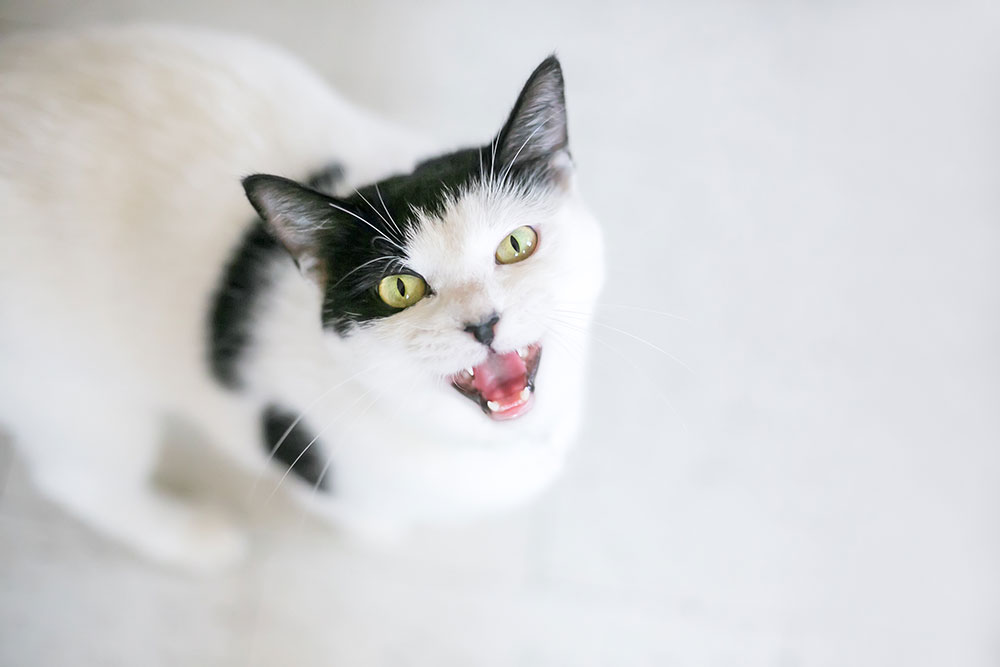5 Common Cat Noises and What They Mean
July 2nd, 2020

While some cats are more talkative than others, cat noises usually communicate their feelings and desires. Most sounds cats make can be interpreted in human language. By knowing what your cat chatter is trying to convey, you’ll better understand your feline friend’s mood and needs.
Here are 5 of the most common cat noises and what they mean:
#1 – Meowing
Everyone is familiar with cat meows. Kittens meow a whole lot to communicate with their moms, while adult cats will more often meow to talk to humans rather than each other. Cat meows don’t all sound the same. The standard meow is mid-length in duration and mid-pitched in tone and is the “asking for something” sound. The mewl, a short high-pitched meow, usually means “hello,” and can be accompanied by rubbing against your legs. A long, drawn-out meow usually means that your furry friend wants something specific, like dinner. Repeated meows may indicate that your cat is excited, while high-pitched meows can mean that your kitty is startled or hurt. Low-pitched meows express unhappiness and are a way for your furry companion to let you know you’ve done something wrong.
#2 – Purring
The most enjoyable cat sound pet parents look forward to is purring, a soft, deep, and throaty rumble, which indicates sheer delight. Gently petting your furry friend is one way to elicit pleasure and have your cat purr away in utter contentment. However, on rare occasions, purring is due to agitation or worry. If your cat’s ears are back and the body seems tense, the purr may be a sign that your pet is unhappy or overwhelmed. Some cats exhibit a nervous purr when visiting their veterinarian.
#3 – Hissing
Hissing usually indicates that your cat feels threatened, angry, or is in pain. Cats usually hiss at other animals. Along with the sound comes a defensive, aggressive posture, including an arched back, puffed up hair, twitchy tail, flattened ears, and an open mouth baring the teeth. At times, cats spit along with hissing. If, however, the hissing is unprovoked, it may be a sign that your pet is in pain with an undiagnosed condition.
#4 – Growling or Snarling
Growling or snarling are aggressive sounds, often accompanying hissing, and usually indicating fear, anger, or territorial threat. A snarling or growling cat will usually display the classic defensive body posture. It is a clear warning to stay back and can be directed at humans as well as other animals. In some cases, a cat in pain may growl or snarl.
#5 – Yowling
A yowl is a long, drawn-out meow that indicates worry, discomfort, territorial concerns, or mating issues. If your cat is continuously yowling, there may be a medical problem that warrants a visit to your vet. If your kitty has not been spayed or neutered, yowling may indicate the search for a mate. Sometimes a cat will yowl out of sheer boredom. Give your kitty a lot of attention and make sure to offer entertainment opportunities.
Learn to Listen to Your Cat
Whatever your cat is trying to say, the important thing is for you to listen. If you have questions about your kitty’s chatter or if you have any health concerns, a visit to All About Cats Veterinary Hospital in Kirkland, WA, will help put your worries to rest. We are here to offer your furry friend purr-fectly compassionate care!
Recent Posts
-
Summer Safety Tips for Cat Owners
July 11th, 2024
-
The ABCs of Cat Vaccinations – What Every Cat Owner Should Know
June 5th, 2024
-
Preparing for Travel With or Without Your Feline Friend
May 3rd, 2024
-
How to Feed Cats in a Multiple-Cat Household
April 8th, 2024
-
8 Tips to Get Your Cat in a Carrier
March 5th, 2024
-
Help, My Cat’s Breath Smells!
February 5th, 2024
-
A Quick Guide to Coping with Cat Emergencies
January 8th, 2024
-
Traveling for the Holidays? 6 Things to Do Before Leaving Your Cat
December 14th, 2023
-
What Is Catnip and Is It Safe for Your Cat?
November 2nd, 2023
-
5 Tips for New Cat Owners
October 5th, 2023
-
How Often Should My Cat Have a Health Check?
September 7th, 2023
-
Cat Hairballs – What Do I Need to Know?
August 4th, 2023
-
How to Play with Your Cat: Fun Cat Activities
July 4th, 2023
-
What to Know About Your Cat’s Surgery
June 10th, 2023
-
Licensed Veterinary Technician or Technician Assistant Wanted (Full time or Part time)
May 15th, 2023
-
Why, Oh Why, Does My Cat Hate Water?
May 9th, 2023
-
What’s Wrong with My Cat? Benefits of Whole-Body Radiology
April 5th, 2023
-
Should I Feed My Cat a Grain-Free Diet?
March 6th, 2023
-
Smelly Cat, Smelly Cat – Causes of Feline Odors
February 22nd, 2023
-
5 Ways to Reduce Cat Shedding
January 3rd, 2023
-
Your Cat’s Holiday Stress – How to Help
December 6th, 2022
-
Pet Cancer Awareness Month: Warning Signs to Look Out For
November 2nd, 2022
-
10 Halloween Safety Tips for Cat Owners
October 3rd, 2022
-
Why Is My Cat So Active at Night?
September 7th, 2022
-
Should I Really Microchip My Cat?
August 9th, 2022
-
Ways to Keep Your Cat Safe and Cool This Summer
July 1st, 2022
-
10 Fascinating Facts About Persian Cats
June 1st, 2022
-
How to Correctly Transition Cat Foods
May 6th, 2022
-
What Your Cat’s Tail Is Secretly Trying to Tell You
April 5th, 2022
-
6 Common Household Items That Are Poisonous to Cats
March 1st, 2022
-
How Do I Know if My Cat Needs Dental Surgery?
February 16th, 2022
-
How to Safely Introduce Your Cat to Your New Baby
January 11th, 2022
-
Giving a Cat as a Christmas Gift: How to Do It Responsibly
December 6th, 2021
-
5 Thanksgiving Foods That Are Toxic to Cats
November 5th, 2021
-
Is My Kitty Depressed? Signs to Look For in a Sad Cat
October 7th, 2021
-
Training Tips for New Kitten Owners
September 7th, 2021
-
Taking Your Cat to the Vet: How to Make It a Stress-Free Experience
August 6th, 2021
-
The Origins and History of the Tabby Cat
July 13th, 2021
-
We are hiring a Veterinary Technician!
July 12th, 2021
-
Kitty Claw Control: How and When to Cut Your Cat’s Nails
June 7th, 2021














